





Grateful thanks to the RHS Members' Advisory Service, and other plant pathologists, especially Nigel Stringer (volunteer at National Botanic Garden of Wales). In particular a lot of the scientific information that I quote, particularly concerning fungal diseases, is from these two main sources.
Aquilegia PESTS & DISEASESFollow the links for further information about some problems. |
||
| PESTS | Aquilegia plants are poisonous which means that very few pests will eat them. | Overall, nothing to really worry about. Sawfly larvae are probably the 'worst' pest but it will depend where you live. |
| APHIDS Controls: Allow the large variety of predators to do their job. If you have a hose out, a squirt on the stem dislodges them. A rapid smoothing of the stem between thumb and finger dislodges them from the stem (and from their proboscis / tongue). Too rapid a movement disbuds the stem, not what is wanted. Get a hand-lens and watch them give birth. |
Probably needing no introduction, greenfly and other aphid populations
can
rapidly increase in spring. In my experience they don't seem to do as much damage as you'd think for so many greedy tongues drinking sap all day long, as I've never seen a flower wilted or deformed because of them. Fascinating insects, as during the spring and summer, rather than laying eggs, many greenfly can give birth to live young that are tiny versions of the adult....which will do the same process in their turn, without even mating in order to give birth. Link for further information on aphids at the RHS site. At least seven types of aphids affect aquilegias, not all are found in the UK. |
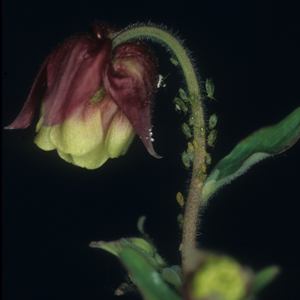 |
| BUMBLE BEES Bombyx spp Control: None. A sense of humour helps, or at least a fascination with the resourcefulness of bumbles. |
WHAT! How can the pollinator of aquilegias be a pest?
Well, not all bumble bees have tongues long enough to drink the nectar in the end of the spur, and none can reach the sugary food in long-spurred aquilegias. However some bumbles can bite their way in and steal the nectar rather than visit the approved way from inside the flower as part of the pollination process. Soon all bumble visitors use the short-cut to the nectar. This biting leads to deformed spurs and thus deformed flowers. I have had to tell many magazine photographers that it is too late, they've missed their chance until next year as all aquilegia flowers in my massive collection are now deformed and non-photogenic. |
|
| LEAF MINER eg Phytomyza minuscula Control: Hopefully none necessary. Enjoy the beautiful lacy effect (!) or take a hand lens and investigate how the larva grew as the tunnel meandered and widened. Is the larva still there or already matured and left, or possibly been eaten itself? |
Fascinating small fly larvae that eat the inside part of the
aquilegia leaf, that tiny area between the upper and lower leaf
surface. Here they are hidden from (most) predators, cannot be washed away by rain, and able to grow larger and larger until finally breaking free and leaving. |
|
| NOCTUID and other MOTH CATERPILLARS Control: Investigate around ground level where you see eaten stems/buds and hand-pick. |
Eaten buds are usually attributed to a dark-coloured
caterpillar hiding around soil level. Loss of buds can be an important issue for me: if it is the only bud on a new seedling, I need to wait another year to see the flower. |
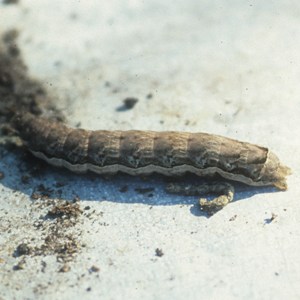 |
| NOCTUID MOTH CATERPILLARS Control: Hand-pick. |
Although eaten buds are usually attributed to the dark-coloured
caterpillar, eaten pods are
likely to have disappeared due to a bright green one that often is feeding during the day.
Loss of buds can be an important issue for me if it is the only bud on a new seedling, I need to wait another year to see the flower. |
|
| POLLEN BEETLES Control. None needed. |
Not much damage, unless you actually want the pollen (for breeding) that they are eating. These were a particular pest for me on Aquilegia 'Flamboyant' in that respect. | |
| SLUGS & SNAILS Control: Mostly a good dose of tolerance. If you really do need to control them, then options are many, varied, needing ongoing enthusiasm, & not particularly effective. |
Fantastic! Aquilegias are slug & snail proof! Well, except for the flowers, as they aren't poisonous like the leaves. So some flowers are at risk, especially ones with large (especially white) petals on low plants in rainy weather. One year I found some small seedlings in my greenhouse HAD been eaten. Poor slug, a whole greenhouse full of only baby aquilegia seedlings, it was eat them and be poisoned or die of starvation. ...and now they also graze plants affected by downy mildew. |
|
| SAWFLY LARVAE Pristiphora aquilegiae Control: Pick caterpillars off leaves when seen, and destroy. If aquilegias are absolutely devastated you may choose to use a suitable insecticide, avoiding during flowering time (to protect pollinators' health). |
The only 'real' pest of aquilegias, as, like other types of
sawfly larvae (Solomon's seal, roses, gooseberry) they can lead
to total defoliation in a heavy infestation. Here, I just keep a
watch out for them eating my baby seedlings, as they have very
little leaf surface and can't cope with voracious feeding. Leaves nibbled away from the outer edge, inwards, often reveals the well camouflaged, tiny green larva hiding just under the leaf edge. Typical question-mark shape. Overwintering in the soil as tiny pupae, the adult emerges very early in spring and uses a saw-like ovipositor to deposit many eggs into the leaf/leaves. |
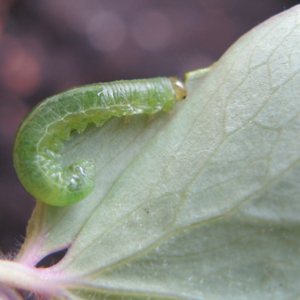 |
| SAWFLY LARVAE Control: Hand-pick the infested leaves and destroy. Infestation at this level on many plants may need chemical treatment outside of the times when aquilegias are flowering. |
I have
only recently seen this type of caterpillar attack, in 2014.
Perhaps it has happened before but I've never noticed it. What I actually saw was the clear windows in the top of the leaf, where the underlying leaf tissue had been eaten away, as well as dead-edged holes in some leaves. The RHS Members' Advisory Service were able to identify these also as aquilegia sawfly even though they look very different to all the ones I have had before, it was explained: 'The aquilegia sawfly continues to breed from spring to late summer and can have 3 or 4 generations.' |
|
| SPIDERS, CRAB 'Control': A camera to take interesting photos. |
Don't worry, crab spiders won't harm your aquilegias, I've
written this entry for sake of completeness and also because I
have rather a soft spot for colour-changing Misumena.
Changing colour from white to yellow or back again, in order to
camouflage themselves, crab spiders tend to be white in white
and lighter coloured aquilegias and yellow (pollen-coloured) in
darker ones. Crab spiders are predatory, laying in wait and seizing their prey rather than using a web to trap. |
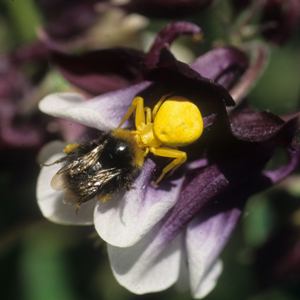 |
| VINE WEEVILS Control: hand-pick adult bugs(& kill) Wash compost from roots of affected plants. Use vine-weevil prevention/treatments, both organic and non-organic options are freely available. Avoid growing in peat (or similar) growing media which encourages many fibrous roots that are ideal food for the grubs. |
Don't seem to eat the leaves, but with this pest it is
always the grub-larvae that do the damage when they eat the
roots. I think I've only found it a problem with seedlings grown
on in peat-based compost (growbags), rather than in nursery rows
in the garden. It is useful to check roots of such plants when
planting out/potting on. If any grubs are found, then wash away
all compost-plus-grubs and do not usereuse. If leaves show wilting, check roots for grubs, though I've not seen an infestation at that level. |
Can't believe I've no digital image of these
C-shaped white larvae. Can you help and supply one to put here? |
| WHITE FLY Control: Encourage biodiversity in your garden and hope natural predators will help a little. Sticky yellow flypapers. Or rotation of suitable insecticides if really necessary. |
I've noticed these tiny white flies flying away as I walk
past and brush the foliage of some aquilegia plants especially
in drier, warmer summers. Worse could happen under cover
(greenhouse/tunnel). The adults will suck the sap, so too do the sedentary scale-like nymphs (also seen in the photo)). Hopefully the eggs will become naturally parasitized (by tiny Encarsia), or scales eaten by predators such as ladybirds, and so infestation never becomes severe. Here's a link to RHS page on glasshouse whitefly. |
|
| AQUILEGIA GALL MIDGE Macrolabis aquilegiae This puzzled me, and I know other aquilegia growers also had non-developing flower buds. (See also, buds affected by downy mildew) Here's what the RHS Members Advisory Service told me: |
“The poor development of flowers on your aquilegia is due to a pest known as the aquilegia gall midge, Macrolabis aquilegiae.This has orange white larvae, up to 2-3mm long, that feed inside the developing flower buds and prevent normal flower development. The midge was first recorded in Britain in 2009. Infested plants have now been found in Kent, Essex, Surrey, Devon and North Yorkshire, indicating that it may be widespread and has gone undetected for a number of years. As it is a relatively new pest in the UK, little is known about its biology. However, it is specific to aquilegias and will not affect any other plants. The larval feeding period is likely to be short, occurring over a few weeks in May, after which the maggots go down into the soil to pupate. There is currently no control for this pest other than the removal of infested flower buds before the larvae have completed their feeding.” Further grateful thanks to the RHS for the use of this image taken by Andrew Halstead. |
|
| SO WHAT ARE THESE??? | Have you seen anything like these in your garden? Can you guess? | |
| Beautiful egg cluster on an aquilegia seedpod, but what could they be? |
Noctuid moth eggs. |
|
| Help!! ... where has the buds on my new A. oxysepala seedling gone (LHS)? |
Probably eaten by a brown noctuid moth caterpillar. I also understand that in rabbit-country that rabbits will eat off new flowering stems .... despite the poisonous nature of aquilegias. |
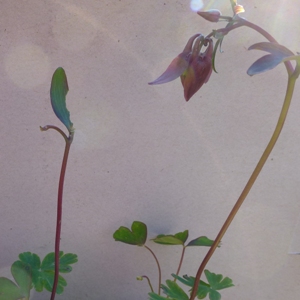 |
| Something's been eating this seedling's leaf... and it's still there, can you spot it?? |
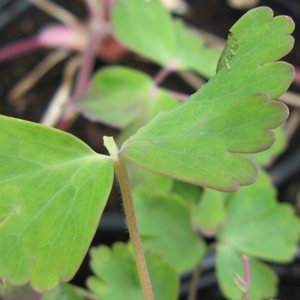 |
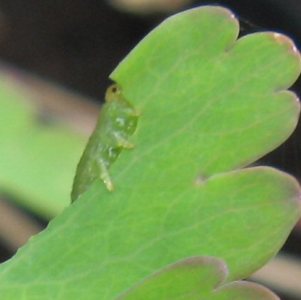 |
| Spotty leaves, like pinpricks that have enlarged, here showing much lighter coloration. |
I was unsure, so I asked the RHS Members' Advisory Service, and was relieved to find it wasn't anything worrying: It is holes caused by the probing of an ovipositor (egg laying mechanism) of a leafmining fly, probably Phytomyza minuscula. Each probe will damage the leaf slightly, and as the leaf grows, the area of damage enlarges. Luckily, not every hole will have had an egg laid within the leaf (in fact here there is no sawfly larva damage). The adult female sawfly will test and check and then lay an egg when fully satisfied. |
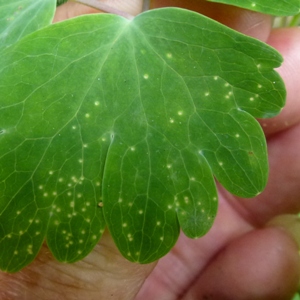 |
| DISEASES | A variety of fungal diseases attack aquilegias. There are no known viral diseases. | Whereas most fungal problems merely weaken the plant, the new downy mildew disease is virulent and kills. |
| POWDERY MILDEW Control: Give good growing conditions. Enough water but not too much, enough nutrients but not overfeeding which gives lush, sappy growth. If necessary there are suitable fungicides to be applied frequently. However, bear in mind that these may adverely affect the soil flora and fauna. Soil fungus is now thought to be very important for soil and plant health. |
Starting as distinctive radiating webby then powdery lines
from a central point of infection, this may eventually cover
both top and bottom surfaces of the leaf. Here in Swansea, it is only in hot dry summers that I am aware of this. I think rainy areas are less conducive to its spread. 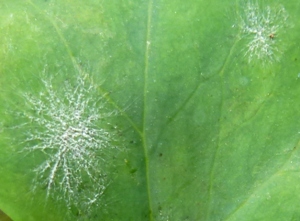 |
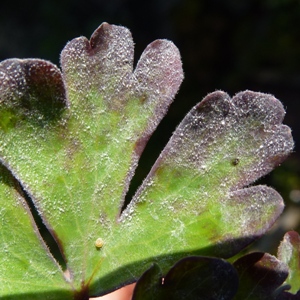 |
|
DOWNY MILDEW (Peronospora sp.) |
A new fungal disease of aquilegias which is killing plants. This is so important that I have 10 interconnected web-pages dedicated to it. Please also tell me your stories about it if it comes to your plants. Before death, symptoms may include: * lighter, yellowy patches on the leaves, delineated by leaf veins. * leaves disintegrating away, leaving just the slightly branched leaf stem. * new shoots/leaves looking lighter green; with smaller leaf area vs leaf stem; and deformed growth. * brown patches on leaves and stems and even flower buds. * secondary damage by grazing slugs and snails. |
|
| Other FUNGAL LEAF SPOTS on aquilegias may be infections by Ascochyta aquilegiae, Cercospora aquilegiae, Septoria aquilegiae or Botrytis cinerea Ref: RHS Members' Advisory Service |
The photo of foliage of A. Spring Magic shows signs of powdery mildew plus Botrytis and possibly other uncommon fungal infections. |
|
| Bacterial leaf spot Pseudomonas syringae |
I've not seen this, it has been recently identified in
commercial crops. Brown, fairly small and distinct, spots on leaves, with dead tissue at the centre, which drops away to form holes. The link on the right gives information. |
http://www.ndrs.org.uk/article.php?id=029004 |
| Back to top |
Copyright Carrie Thomas 2014. Web wizardry by Trevor Rees. All rights reserved.